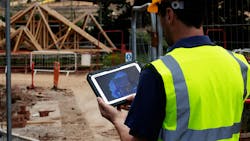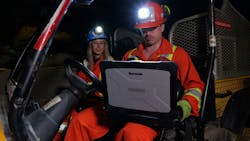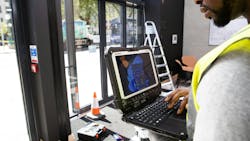Key Insights
In this article, you will learn:
- How rugged laptops and tablets can help reduce equipment downtime.
- How rugged computers interact with advanced construction equipment.
- Features of rugged computers.
- How adopting emerging technologies attracts Gen Z talent.
Equipment downtime is a significant challenge to an industry that operates on tight timelines and faces high productivity demands. When heavy equipment such as excavators, crawler dozers, and cranes are offline, each hour of downtime can cost between $75 and $400. This equates to hundreds of thousands of dollars lost over time and causes headaches for companies, workers, and customers.
Reducing heavy machinery downtime starts with giving workers the tools they need to act quickly, work accurately, and stay connected no matter where the job takes them. Rugged laptop and tablet solutions help bridge the gap between increasingly complex machinery and a workforce under pressure, leading to a reduction in costs and more projects kept on schedule. By investing in the right technology, construction companies can maximize uptime, attract the next generation of talent, and lay the foundation for a more resilient construction industry to come.
Rugged computers aid field maintenance
Equipping field technicians and other field personnel with the right tools and technologies can minimize downtime, streamline diagnostics, and speed up repairs of critically important machinery. As equipment becomes more sophisticated and labor shortages continue, keeping machines running at peak efficiency is increasingly difficult.
Rugged laptops and tablets are purpose-built computers that are engineered for the rigors of challenging indoor, outdoor, and remote environments. Unlike consumer grade devices, they are designed to be used in extreme weather and uncompromising environments, including heat, dust, dirt, moisture, and more.
Features of rugged laptops
Digital transformation is non-negotiable in construction. But doing so outside the controlled four walls of an office is a much more difficult proposition. Rugged laptops feature MIL-STD ruggedness, IP-rated protection, modular ports for connectivity, hot-swappable batteries, glove-touch, unique thermodynamics, and more. Furthermore, with multiple wireless options, including 4G, 5G, and other industry-specific LTE networks, rugged mobile solutions are also better equipped to keep diagnostic teams connected no matter where they are doing work.
More maintenance management
- Understanding equipment utilization and availability metrics.
- How to hire technicians for the long term.
- Strategies to better manage diesel fuel costs.
As such, rugged computers empower equipment managers and field technicians to perform faster diagnostics and maintain optimal equipment performance. They can assess and predict equipment health, help mitigate labor challenges by enhancing maintenance efficiency, and enable construction companies to navigate the growing complexity of their machinery.
Enabling quick, accurate equipment checks and supporting predictive maintenance capabilities keeps machines in rotation longer and allows a proactive approach to maintenance. Using rugged computing in the field, technicians can connect directly to a machine’s onboard diagnostics from a number of different locations, run health reports in real time, and address issues before they turn into costly breakdowns.
Plus, remote diagnostic capabilities mean experts can troubleshoot without physically being on each individual site, reducing delays even further by eliminating the need to wait for a specialist to be present. With rugged computing, the repair shop can be brought to the field with confidence.
Automated reporting is another major benefit of rugged mobile solutions. Instead of spending hours filling out paper forms after servicing a machine or waiting until they’re back in the office to type up a report, diagnostic technicians can complete and submit digital work orders on the spot—with instant syncing to project managers and maintenance logs. The result is less time spent on admin and more time keeping equipment running.
Tools for construction equipment technology
Equipment today is more advanced than ever. The American Institute of Contractors lists autonomous construction equipment as one of the top examples of high-tech machinery that brings a variety of benefits, including reduced human error, enhanced productivity, and improved safety. This—and innovative technology like artificial intelligence (AI) —will continue to transform construction workflows and revolutionize the way equipment is monitored and serviced in the field.
Today’s heavy equipment is sophisticated, running on GPS-enabled control systems and featuring IoT-connected sensors, which require specialized maintenance knowledge. Rugged laptops and tablets give technicians the ability to interface with both modern and legacy equipment at the point of service. Unlike traditional computers, these rugged solutions can be customized by users in near-real time out in the field to give workers a critical tool based on the fleet they are servicing.
For example, barcode readers can be added to log and track replacement part inventory, or additional storage drives to securely store large diagnostic files and equipment manuals. Plus, with multiple ports and compatibility across a range of software platforms, field teams can easily plug in and service any machine on site.
Taking this one step further, integrations with innovative diagnostic tools and software gives field workers faster, more accurate ways to handle repairs at the point of service, keeping machinery in rotation longer. Connecting these tools to a rugged computer also improves the quality of data capture, such as digital video and imagery, as opposed to written notes. This is important to an industry that has traditionally underutilized data that it produces , and it gives workers a more reliable way to capture and access it.
How technology attracts new work force
Companies that adopt emerging technologies also have a competitive advantage in attracting new, skilled talent. Incoming Gen Z employees expect advanced technology to be integrated into their work environments.
Rugged laptops and tablets are purpose-built for construction environments, with long battery life, sunlight-readable displays, glove-friendly touchscreens, and resistance to dust, moisture, and drops. These tools keep experienced technicians productive and also help onboard less experienced workers more quickly by giving them a tool with everything they need in one place. No more searching through binders of manuals, juggling multiple devices, or waiting on office staff to send critical information.
Workers can accomplish more in less time, helping the already strained workforce and improving employee satisfaction and retention with the best tools available to complete projects.
Anyone who has used a personal device in the sun or out in the elements knows the frustrations that can come with mobile computing, including overheating that affects performance, poor battery life from intensive computing tasks, and touch functionality or sound quality affected by water or dirt. Imagine that was the worker experience in an enterprise setting, making the job at hand even more difficult.
Rugged computing design qualities bring modernization to the field.
About the Author
Michael Trafton
Michael Trafton is a business development manager for Panasonic Connect North America. He has deep knowledge of and experience with technology solutions and applications for the enterprise space. He develops and implements strategic business plans to support and grow Panasonic Connect’s business, with customer relationship management and customer experience at the core. Michael earned his bachelor’s degree in business and economics at Randolph-Macon College.


